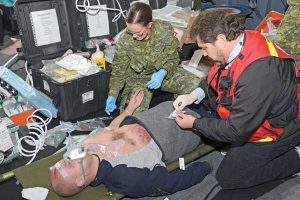SMASHEX: Navy-led exercise simulates catastrophe
By Lookout on Oct 07, 2013 with Comments 0

Lt Laura Brunet sets up an intravenous line with Dr. George Benloulou to a simulated casualty on HMCS Calgary.
The hangar of HMCS Calgary was like a Hollywood set last Wednesday, complete with people in realistic makeup that simulated gruesome injuries.
Skilfully attending to them were civilian doctors and military medical officers, with assistance from Calgary’s casualty clearance team, all participants in the submarine search and rescue exercise known as SMASHEX.
The navy-led exercise prepares military and civilian medical personnel for the possibility of a submarine catastrophe.
“Thankfully, submarine emergency rescue isn’t something we’ve had to deal with,” says LCol Nick Withers, Pacific Regional Surgeon and member of the Submarine Escape and Rescue Assistance Team (SMERAT). “That being said, it’s a very real possibility and something the Department of National Defence needs to be prepared for.”
The exercise began in the waters off Colwood when a submarine failed to respond to radio communication. Soon after, people in immersion survival suits appeared in the harbour waiting to be rescued after escaping a fictional
sinking submarine.
Calgary, berthed at F jetty in Colwood, served as the rescue platform, with ship divers and zodiac crews plucking survivors from the water. Once retrieved, survivors were hoisted on deck in an inflatable retrieval basket called a Billy Pugh.
CPO1 Brian Schwenker, Calgary coxswain, says the exercise was a great way to promote teamwork in the face of disaster.
“In times like this we need to operate like a well-oiled machine, not as a series of parts,” he says. “Training opportunities like this give us the chance to keep warm the skill we may one day need to save lives.”
Following initial treatment in Calgary’s makeshift triage unit, casualties were tagged with internationally recognized triage cards indentifying the level of injury, and taken to Victoria General Hospital, where preparations had been made to receive mass casualties. LCol Withers says in the event of a real disaster the hospital could become overwhelmed by a sudden influx of patients.
“It’s important we work with local medical facilities as this is where we’ll be taking our injured if a disaster were to occur,” he says. “As a member of DND it’s really an honour to work with the people at VGH to ensure we’re prepared to work together as a cohesive team in the event of tragedy.”
It took planners six months to develop and execute the SMASHEX, from the events that led to the submarine’s evacuation to the specific ailments and injuries of each casualty.
LCol Withers says makeup and role-playing added a level of realism necessary to drive home the importance of training.
“In the field, medical situations are constantly evolving,” he says. “By simulating those conditions in an exercise personnel will be far better prepared should the real thing ever come to pass.”
-Shawn O’Hara, Staff Writer
Filed Under: Top Stories
About the Author:





